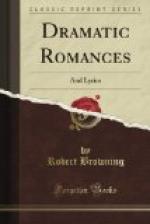XXX
Burningly it came on me all at once,
This
was the place! those two hills on the right
Crouched
like two bulls locked horn in horn in fight;
While to the left, a tall scalped mountain . . .
Dunce,
Dotard, a-dozing at the very nonce,
After
a life spent training for the sight! 180
XXXI
What in the midst lay but the Tower itself?
The
round squat turret, blind as the fool’s heart,
Built
of brown stone, without a counterpart
In the whole world. The tempest’s mocking
elf
Points to the shipman thus the unseen shelf
He
strikes on, only when the timbers start.
XXXII
Not see? because of night perhaps?—why,
day
Came
back again for that! before it left,
The
dying sunset kindled through a cleft:
The hills, like giants at a hunting, lay,
190
Chin upon hand, to see the game at bay,—
“Now
stab and end the creature—to the heft!”
XXXIII
Not hear? when noise was everywhere! it tolled
Increasing
like a bell. Names in my ears
Of
all the lost adventurers my peers,—
How such a one was strong, and such was bold,
And such was fortunate, yet each of old
Lost,
lost! one moment knelled the woe of years.
XXXIV
There they stood, ranged along the hill-sides, met
To
view the last of me, a living frame
200
For
one more picture! in a sheet of flame
I saw them and I knew them all. And yet
Dauntless the slug-horn to my lips I set,
And
blew. “Childe Roland to the Dark Tower
came.”
Notes: “Childe Roland” symbolizes the conquest of despair by fealty to the ideal. Browning emphatically disclaimed any precise allegorical intention in this poem. He acknowledged only an ideal purport in which the significance of the whole, as suggesting a vision of life and the saving power of constancy, had its due place. Certain picturesque materials which had made their impressions on the poet’s mind contributed towards the building up of this realistic fantasy: a tower he saw in the Carrara Mountains; a painting which caught his eye later in Paris; the figure of a horse in the tapestry in his own drawing-room—welded together with the remembrance of the line cited from King Lear, iii. 4, 187, which last, it should be remembered, has a background of ballads and legend cycles of which a man like Browning was not unaware. For allegorical schemes of the Poem see Nettleship’s “Essays and Thoughts,” and The Critic, Apr. 24, 1886; for an antidote to these, The Critic, May 8, 1886; an orthodox view, Poet-lore, Nov. 1890: for interpretations touching on the ballad sources, London Browning Society Papers, part iii. p. 21, and Poet-lore, Aug.-Sept. 1892.




